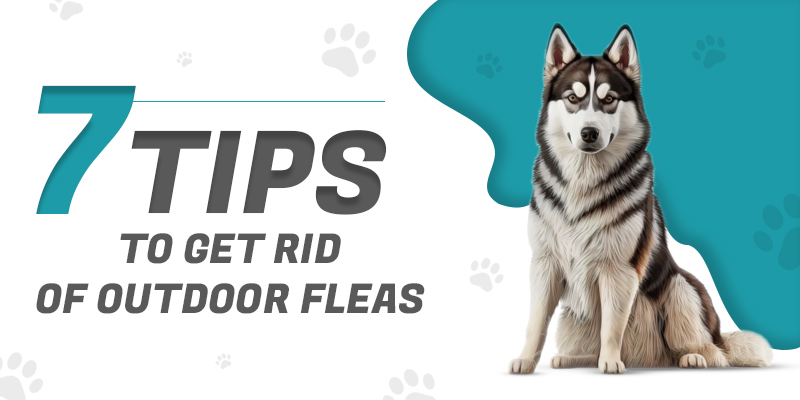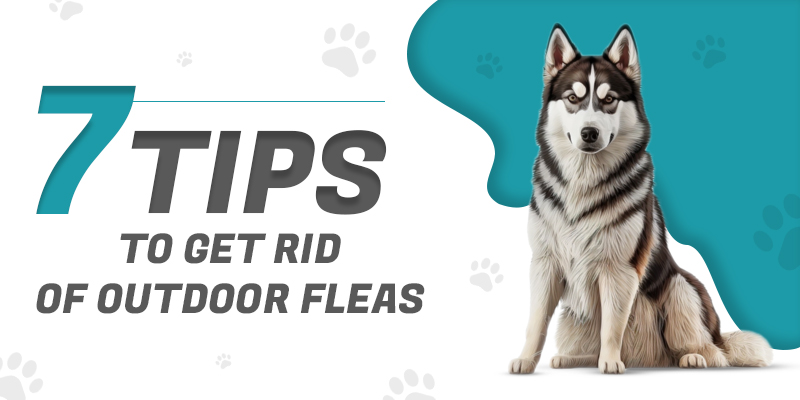7 Tips to Get Rid of Outdoor Fleas


Fleas are notorious pests that can make our furry friends’ lives miserable. However, fleas are not just limited to your pet’s coat; they can infest your home and yard, creating a vicious cycle that is challenging to break.
Fleas are literally out there to attack your dog. By taking a comprehensive approach, you can protect your pet and your backyard or garden from these pesky pests. In this blog, we will discuss effective ways to deal with the fleas present in the outdoors. So, let’s begin!
Getting Rid of Fleas in Your Yard/Garden
It is essential to eliminate fleas to effectively get rid of fleas outdoors, and to protect your dog from discomfort and diseases. Fortunately, there are several effective strategies as mentioned here to get rid of fleas in your outdoors and prevent future infestations.
1. Maintain Cleanliness
Fleas thrive in moist, shady areas with plenty of organic debris. Keeping your yard well-maintained can help reduce the likelihood of a flea infestation. Regularly mow the lawn, trim tree branches and shrubs, and remove leaf litter and other organic debris. This will eliminate hiding spots for fleas and make your yard less attractive to these pests.
[Also Read] Top 10 Ways To Prevent Fleas and Ticks on Dogs
2. Use Flea Treatments
Flea sprays containing permethrin and insect growth regulators like methoprene or pyriproxyfen can effectively kill adult fleas, eggs, larvae, and pupae, disrupting their life cycle. Spray the yard with a professional insecticide concentrate, targeting infested areas like the base of trees, shrubs, and under decks. Always follow the manufacturer’s instructions and use caution when handling insecticides. For extra caution, do not allow your pet to lick anything for a few hours.
3. Monitor Your Yard
Regularly monitor your yard for signs of fleas, such as small, dark specks (flea droppings) or jumping insects. If you suspect a flea infestation, take action immediately to prevent it from spreading. If you have a severe flea infestation, consider hiring a professional pest control service. These services can provide targeted treatments and ongoing maintenance to keep your yard flea-free.
4. Try Beneficial Nematodes
Nematodes can be used to eliminate fleas in your yard. They are small, non-segmented worms that take fleas as their hosts and live on the nutrients they provide. You can use beneficial nematodes like Steinernema feltiae (Sf), Steinernemacarpocapsae (Sc) and Heterorhabditis bacteriophora (Hb) in your garden to quickly eliminate fleas as well as other buggers like cut worms, gant larvae, weevils, webworms, beetles, and more. You simply have to spread them in your garden by mixing with water in appropriate amounts, as mentioned on the packaging.
5. Use Desiccants
Desiccants like diatomaceous earth, silica gel, baking soda, and sodium borate pull water from the flea (egg, adult, and pupae), causing them to dry up and die. Desiccants are safe for dogs, cats, humans, or other mammals. You can simply sprinkle your choice of desiccant in your yard, concentrating on areas where your pet hangs out the most. It will kill fleas and help you get rid of the flea infestation in your yard.
6. Avoid Overwatering
Fleas thrive in moist environments, so avoid overwatering your lawn and garden. This will create a less hospitable environment for fleas and reduce the likelihood of an infestation. However, you can occasionally flood the yard with water to drown fleas and their life cycle stages, including eggs and larvae. If you do so, try your best to dry out the yard in the best possible way, as any moisture again can give fleas a suitable environment to thrive.
7. Preventive Measures
Prevention is always better than cure. So, always take appropriate measures to prevent fleas on your pet, in your house, and in the backyard. Keeping the grass trimmed, maintaining irrigation systems, and clearing debris regularly can effectively help discourage flea infestations. You should also regularly pest-proof your house, bathe pets weekly, and vacuum indoors to prevent fleas from returning. With the help Of these Things, you can Get rid of flea infestation in pets.
Bottom Line
By combining these strategies, you can effectively combat fleas outdoors and create an environment that is less hospitable to pests like fleas and ticks. However, we highly recommend using an effective flea and tick treatment for your dog to protect them from these nasties, irrespective of whether or not they are present in your home, yard, garden, or surroundings

David joined CanadaVetCare in 2013 as a product analyst and veterinary assistant. Being a passionate pet lover and keen animal health researcher, David had always found ways and solutions to help pet parents to improve their pets’ health. He is always happy to answer pet health-related queries and recommending pet parents for the right pet product for their furry companions.




